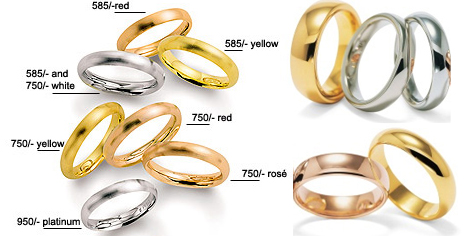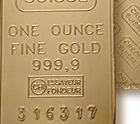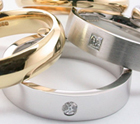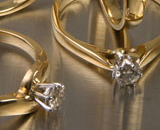


Gold's
natural color is further enhanced by alloying it with small amounts
of other metals. Jewelers create yellow, rose, green and white golds
by using different alloys. More copper results in a soft rose color;
additional silver creates green gold; and palladium produces white.
Properties:
Gold is very durable and look no further than the nearest museum
where gold jewelry, coins and artifacts from ancient civilizations
attest to the metal's enduring beauty and permanence. Jewelers
throughout the ages have preferred gold to all other metals for its
beauty and ease of workmanship. Gold can be melted, or shaped, to
create any design. It can be alloyed with a number of other metals to
increase its strength and produce a variety of colors.
Colors of Gold: Gold comes in a variety of colors. Because gold is alloyed with other metals to increase its strength, it can also be made in a variety of colors. For example, yellow gold is created by alloying the metal with copper and silver; using copper only creates pink gold; white gold contains platinum or palladium, zinc and copper; green gold contains silver, copper and zinc.

24K Gold: Pure gold, or 24-karat, is generally considered too soft for use in jewelry, so it is alloyed with other metals to increase its strength.
18K Gold: 18K Gold is 18/24ths, or three-quarters pure gold. Jewelry of this fineness is marked "18k" or "750," meaning 75 percent gold.
14K Gold: In the United States, 14-karat gold is used most commonly for jewelry. Fourteen-karat gold is 14/24ths, or slightly more than one-half pure gold. Jewelry of this fineness is marked "14k" or "585," the European designation meaning 58.5 percent gold.
10K Gold: Nothing less than 10-karat gold can be legally marked or sold as gold jewelry in the United States. These pieces are marked "10k" or "417," the European designation meaning 41.7 percent gold.
Stamping: Look for trademarks accompanying the quality mark. When a piece of jewelry is stamped with a quality mark, law requires that it be stamped with a hallmark or trademark as well. Sometimes the jewelry is also marked with its country of origin. These designations are designed to assure you that you are buying genuine gold jewelry of the karatage marked.

Gold Pricing:
Gold Pricing is based on four factors: karatage, gram weight, design
and craftsmanship. The karatage and gram weight tell you how much
gold is in a piece, but other crucial factors determining price are
the piece's construction and design. A price based solely on gram
weight does not reflect the work that has gone into the piece. It's
important to remember that each piece of gold jewelry is unique and,
if cared for properly, can last a lifetime.
White Gold:
White gold is an alloy of gold and some white metals such as nickel,
silver and palladium. White gold can be 18k, 14k, 9k or any karat.
For example, 18k yellow gold is made by mixing 75% gold with 25%
other metals such as copper and zinc. 18k white gold is made by
mixing 75% gold with 25% other metals such as nickel, silver and
palladium. So the amount of gold is the same but the alloy is different.
Platinum: Platinum was used by the South American Indians before the fifteenth century. They could not melt it, but developed a technique for sintering it with gold on charcoal, to produce artefacts. Know More About Authentic Metals.

Pay special attention to fasteners or clasps, making sure catches work easily but are secure. Likewise, the backs of pins and earring posts should be strong and firmly attached to the piece with no soldering marks visible. With gold chain, lay it flat and make sure the links don't kink or bend.

Protect your gold jewelry by storing it safely or keeping it wrapped in a soft cloth when not being worn. Clean your gold jewelry with a cleaning solution of sudsy lukewarm water, or bring it to your local jeweler and have it steam-cleaned. Dry and polish jewelry with a chamois or soft cloth after cleaning and rinsing. Keep gold jewelry free from dust, moisture, perspiration and makeup.
![]()
Why
Buy From Us | References
| Site Security
| Guarantee | Return
Policy | Buyer's
Tips | FAQ | Site
Map
Product
Education | Live
Online Help | Search
Our Website | Customer
Service | Contact
Us | Payment Options
| Sales Tax
Shipping
Charges | Service
Center | Order
Tracking | Platinum
Facts | Ring Sizing
| Engraving Options
| Polishing
How
To Order | After
Sales Service | Legal
| Terms & Conditions
| Disclaimer | Product
Policies | Security
info@sndgems.com | © 2000 Sndgems Inc. | 1-800-871-1066 / 1-614-921-9024